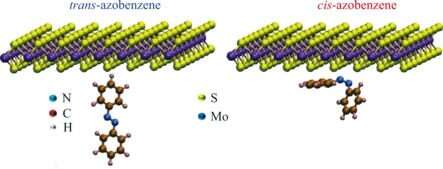Hybrid material may outperform graphene in several applications

Materials that are hybrid constructions (combining organic and inorganic precursors) and quasi-two-dimensional (with malleable and highly compactable molecular structures) are on the rise in several technological applications, such as the fabrication of ever-smaller optoelectronic devices.
An article published in Physical Review B describes a study led by Diana Meneses Gustin and Luís Cabral, who explain theoretically the unique optical and transport properties resulting from the interaction between a molybdenum disulfide monolayer, inorganic substance MoS2, and a substrate of azobenzene, organic substance C12H10N2.
Illumination makes the azobenzene molecule switch isomerization and transition from a stable trans spatial configuration to a metastable cis form, producing effects on the electron cloud in the molybdenum disulfide monolayer. These effects, which are reversible, had previously been investigated experimentally by Emanuela Margapoti in postdoctoral research conducted at UFSCar and supported by FAPESP.
Gustin and Cabral developed a model to emulate the process theoretically. "They performed ab initio simulations [computational simulations using only established science] and calculations based on density functional theory [a quantum mechanical method used to investigate the dynamics of many-body systems]. They also modeled the transport properties of the molybdenum disulfide monolayer when disturbed by variations in the azobenzene substrate," researcher Lopez Richard explained.
While the published paper does not address technological applications, the deployment of the effect to build a light-activated two-dimensional transistor is on the researchers' horizon.
"The quasi two-dimensional structure makes molybdenum disulfide as attractive as graphene in terms of space reduction and malleability, but it has virtues that potentially make it even better. It's a semiconductor with similar electrical conductivity properties to graphene's and it's more versatile optically because it emits light in the wavelength range from infrared to the visible region," Richard said.
The hybrid molybdenum-disulfide-azobenzene structure is considered a highly promising material, but a great deal of research and development will be required if it is to be effectively deployed in useful devices.
More information: D. Meneses-Gustin et al, Photomodulation of transport in monolayer dichalcogenides, Physical Review B (2018). DOI: 10.1103/PhysRevB.98.241403
Journal information: Physical Review B
Provided by FAPESP




















